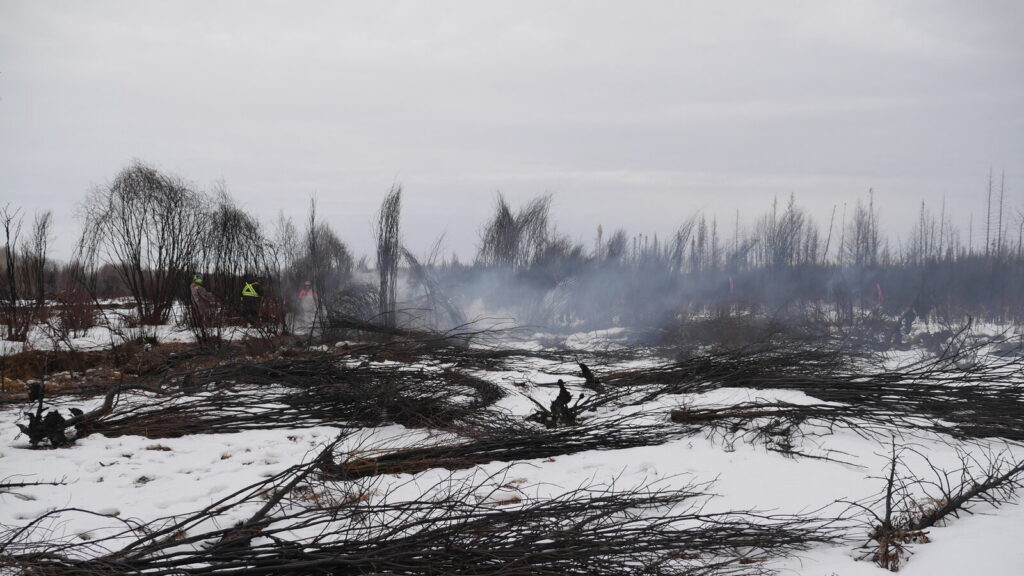The Rise of Year-Round Wildfires in Canada
In recent years, Canada has experienced a troubling increase in the number of year-round wildfires, particularly in its northern regions. This alarming trend is significantly impacted by the phenomenon of “zombie fires”—fires that remain smoldering underground during winter, only to reignite as conditions warm up in spring. As a result, researchers and firefighting teams are urgently looking for effective strategies to combat these persistent blazes.
Persistent Smoldering Under Snow
Marty Wells, a wolf trapper and fire crew leader, witnessed the troubling signs of these zombie fires firsthand, even under severe winter conditions of -40°C (-40°F). As he traveled north from Fort Nelson, British Columbia, he noted the strange sight of smoke billowing up from under the snow and hot spots that appeared like springs in the frozen landscape. “Once it gets into the muskeg, it burns underground and can pop up elsewhere,” he explained.
When the snow began to melt in early May, these dormant fires flared up again, igniting a significant wildfire that spread over an area of approximately 700 square kilometers (270 square miles). Fort Nelson is now engulfed in a series of blazes, with one fire growing larger to the east and a new wildfire threatening properties just 2.5 kilometers (1.6 miles) to the west. The rapidly changing conditions have led to the evacuation of residents.
Factors Contributing to Wildfire Growth
The year 2023 set a record for wildfires in Canada, with an astonishing 185,000 square kilometers (71,429 square miles) consumed by flames—roughly the same size as Syria. The western provinces, particularly Alberta, British Columbia, and the Northwest Territories, have been disproportionately affected, compounded by three consecutive years of drought and significantly reduced snowpack levels.
According to Mike Flannigan, a fire scientist at Thompson Rivers University, the number of overwintering fires has increased, posing a new challenge for firefighting efforts. “We’ve never seen an outbreak of zombie fires like this before,” he remarked, noting the negative impact on the region’s ecosystems.
The Scientific Background of Zombie Fires
Peat, a carbon-rich soil that forms in wet, oxygen-poor conditions, underlies the fires responsible for creating these zombie outbreaks. Inside the Hazelab at Imperial College London, researchers are conducting experiments with peat to uncover how it behaves in various moisture conditions. Early findings show that dry peat burns much faster than moist peat, providing insight into how climate change and land drainage practices increase wildfire risks.
Zombie fires have been reported for decades, but scientific interest has surged recently. Research indicates that warmer temperatures and intense heat from recent wildfires may create a feedback loop, fueling future zombie fire outbreaks.
Impact on the Ecosystem
The implications of these recurring fires are profound. The transition from boreal forests to alternative ecosystems could endanger species like woodland caribou. Studies indicate that repeated wildfires can lead to landscapes resembling barren moonscapes instead of vibrant forests.
Table: Comparison of Wildfire Statistics
| Year | Area Burned (sq km) | Consequences |
|---|---|---|
| 2023 | 185,000 | Record fire season, extensive evacuations |
| 2020 | 100 | Severe wildfires above the Arctic Circle |
| 2014 | Significant | “Summer of smoke” worsened by holdover fires |
Taking Action Against Zombie Fires
Efforts to curb these zombie fires have been complicated by their remote locations and the finite resources available for firefighting. The best preventive measure, however, remains addressing climate change by significantly reducing carbon emissions. Local communities, like that of Tyanna Steinwand from the Tłı̨chǫ first nation, are feeling the emotional and physical strain caused by smoke and the threat of wildfires to their land and lifestyle.
As the implications of these zombie fires unfold, it’s clear that Canada faces an urgent challenge in managing its increasingly perilous wildfire season.


